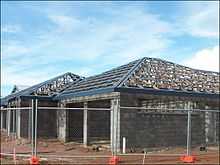Hip roof

A hip roof, hip-roof[1] or hipped roof, is a type of roof where all sides slope downwards to the walls, usually with a fairly gentle slope. Thus it is a house with no gables or other vertical sides to the roof. A square hip roof is shaped like a pyramid. Hip roofs on houses could have two triangular sides and two trapezoidal ones. A hip roof on a rectangular plan has four faces. They are almost always at the same pitch or slope, which makes them symmetrical about the centerlines. Hip roofs have a consistent level fascia, meaning that a gutter can be fitted all around. Hip roofs often have dormer slanted sides.
Construction




Hip roofs are more difficult to construct than a gabled roof, requiring somewhat more complex systems of rafters or trusses. Although the roof itself is harder to construct, the walls that carry the roof are easier to build, being all one level. Hip roofs can be constructed on a wide variety of plan shapes. Each ridge is central over the rectangle of the building below it. The triangular faces of the roof are called the hip ends, and they are bounded by the hips themselves. The "hips" and hip rafters sit on an external corner of the building and rise to the ridge. Where the building has an internal corner, a valley makes the join between the sloping surfaces. They have the advantage of giving a compact, solid appearance to a structure. The roof pitch (slope) may vary.
Use
In modern domestic architecture, hip roofs are commonly seen in bungalows and cottages, and have been integral to styles such as the American Foursquare. However, the hip roof has been used in many different styles of architecture and in a wide array of structures.
A hip roof is self-bracing. It does not need the same amount of diagonal bracing (wind bracing) that a gable roof requires.
Advantages and disadvantages
A possible disadvantage of a hip roof, compared with a gable roof on the same plan, is that there is less room inside the roof space; access is more difficult for maintenance; hip roofs are harder to ventilate; and there is not a gable with a window for natural light. Hip roofs generally perform better in extreme winds than other designs because they have fewer sharp corners and a shallower slope, have an inherently more stable structure,[2][3] and have a lower profile.
Variants
Mansard roof
A mansard roof is a variation on a hip roof, with two different roof angles, the lower one much steeper than the upper.
Tented roof
A tented roof is a type of polygonal hipped roof with steeply pitched slopes rising to a peak or intersection.
Gablet roof or Dutch gable

Another variation is the gablet (UK terminology) or Dutch gable roof (U.S. and Australasian terminology), which has a hip with a small gable (the gablet) above it. This type simplifies the construction of the roof; no girder trusses are required, but it still has level walls and consistent eaves.
Half-hip roof

A half-hip, clipped-gable or jerkin head roof has a gable, but the upper point of the gable is replaced by a small hip, squaring off the top of the gable. The lower edge of the half-hip may have a gutter which leads back on to the remainder of the roof on one or both sides. Both the gablet roof and the half-hipped roof are intermediate between the gabled and fully hipped types: the gablet roof has a gable above a hip, while a half-hipped roof has a hip above a gable.
Half-hipped roofs are very common in Denmark, Germany and especially in Austria and Slovenia. They are also typical of traditional timber frame buildings in the Wealden area of South East England.
Half hip roofs are sometimes referred to as "Dutch hip", but this term is easily confused with "Dutch gable".
Pavilion roof
A hip roof on a square structure typically found topping gazebos and other pavilion structures, also known as a pyramid roof.
Rhenish helm or Helm roof
A pointed roof seen on a spire or a tower, oriented so that it has four gable ends. See Church of St Mary the Blessed Virgin, Sompting, Speyer Cathedral or Limburg Cathedral.
See also
References
- ↑ Curl, James Stevens (2006). Oxford Dictionary of Architecture and Landscape Architecture, 2nd ed., OUP, Oxford and New York, p. 364. ISBN 978-0-19-860678-9.
- ↑ "Design and Construction Guidance for Community Safe Rooms". FEMA. Retrieved 8 April 2013.
- ↑ Grazulis, Thomas P. (1993). Significant tornadoes, 1680-1991. St. Johnsbury, Vt.: Environmental Films. p. 106. ISBN 1-879362-03-1.